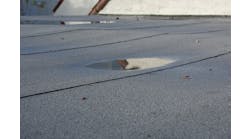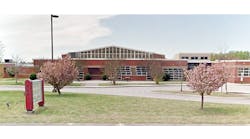Roofs are among the most misunderstood-and neglected-building components. And like other building components, they eventually wear out and require replacement.
However, normal aging and eventual deterioration is different than roof failure, where the roof system fails to attain its design life. The service life of a roof system is dependent on the quality of the original roofing materials, the appropriateness of design and material selection, and the care and quality of installation. Another important factor influencing a roof system's longevity is roof maintenance.
An effective preventive-maintenance (PM) program does not wait for problems to develop, but instead schedules regular roof inspections and promptly attends to required repairs. The best time to develop a PM program is during the design and installation of a new roof system. However, in most cases, facility managers must deal with existing roofs as part of their duties.
The first step
It is difficult to fix a problem without first knowing what the problem is. In roof management, the first step is to identify what roofs are owned and what condition they are in. Gathering historical information and cataloging roofing assets is tedious and time-consuming, but necessary. The following information should be identified:
-Date of installation.
-Installing contractor.
-Roof-system manufacturer.
-Existence and duration of warranties.
-Type of membrane, insulation and roof deck.
-Leak history, including any warranty claims and their resolutions.
-Repair history, including dates, type and repair costs.
For newly completed roofs, the following information should be compiled during installation and should be part of the closeout document:
-As-built plans and specifications, including any addenda.
-Current roof plans showing locations of penetrations and equipment.
-Minutes of pre-bid and pre-construction meetings.
-Shop drawings and product data.
-Daily quality-assurance reports.
-Change orders.
-Correspondence relating to the installation of the roof system.
-Manufacturer or contractor warranties.
-Documentation of roof inspections or evaluations, including photos.
-Documentation of changes made to the roof or new equipment installed.
-Documentation of repairs or corrective action.
The roof inspection
Proper management of roofing assets requires both knowledge of the roof's history and its current condition. Current roof-condition information is obtained by conducting roof surveys or inspections. Roof inspections should be performed by a competent person at least twice a year-in the spring and fall. During the spring survey, observe any winter damage, making repairs during favorable weather. Fall surveys allow problem identification and repair of the roof before the weather turns colder. Also, additional surveys should be performed after major storms or construction.
During the survey, be sure to:
-Examine roof membrane, flashings, sheet-metal flashings, drains, gutters, etc.
-Evaluate observed conditions, such as ponding water or traffic patterns, that may impact the long-term performance of the roof system.
-Document deficiencies requiring corrective action.
-Develop long-range preventive-maintenance needs.
Survey documentation should consist of a written report or checklist, photographs and notes on a roof plan indicating the conditions observed. The roof plan should supply enough data to facilitate performance of the required repairs. Several checklists are available for documenting conditions observed during a survey.
Frequency of tasks
How often you need to perform the various tasks associated with a roof PM program depends on the age and condition of the roof, environmental influences, rooftop traffic, occupancy sensitivity, size and roof accessibility. The following guidelines can help determine the frequency of the tasks:
-Perform comprehensive visual roof surveys semi-annually. For large roof areas in good condition with limited rooftop traffic, perform a comprehensive survey in the spring. Do limited overview surveys in the fall to ensure integrity prior to winter weather.
-Conduct warranty surveys before the contractor or manufacturer's warranty expires. This allows the repair of any deficiency covered before the expiration of possible monetary obligations.
-Perform housekeeping surveys on most roof areas monthly. These surveys help identify potential problems. You might need to increase the frequency of these surveys. For example, during the fall, roofs adjacent to trees may require crews to remove vegetation weekly.
-Schedule corrective steps or repairs soon after the survey. If corrective action is delayed, small isolated deficiencies may become major problems that can be expensive and difficult to repair.
-Conduct roof-moisture surveys on three-year cycles unless specific conditions exist that warrant more frequent surveys or moisture is suspected to be in the roof system. Perform the first or baseline survey before the contractor's warranty expires so repairs can be covered under the terms of the warranty. In any case, the first roof-moisture survey should be performed within the first two to three years after installation. Non-invasive moisture-testing technologies-infrared thermography, electric capacitance and nuclear detection-allow an inspector to test for moisture in roofing materials without having to cut into or otherwise create penetration in the roof.
The person performing visual roof surveys should be familiar with the design, installation, repair and types of failure specific to the roofing system being surveyed. Whether surveys are done by in-house staff or contracted to a consultant depends on technical competence and availability of resources. In-house personnel who have had training in roof inspection, diagnosis and repair can perform limited overview surveys, such as those done in the fall.
Consider assigning housekeeping surveys to employees responsible for daily building preventive-maintenance duties. These duties would include cleaning roof drains and scuppers, and the removal and disposal of debris. Housekeeping and minor PM activities, such as filling pitch pans, usually can be performed with in-house personnel. Generally, minor repairs also can be performed using industry-standard repair materials and procedures. This eliminates the need to develop lengthy repair specifications.
If repairs are specialized or extensive, develop detailed repair plans and specifications to aid in obtaining competitive pricing. Also, roofs covered by an active warranty should be repaired by a manufacturer-approved roofing professional.

